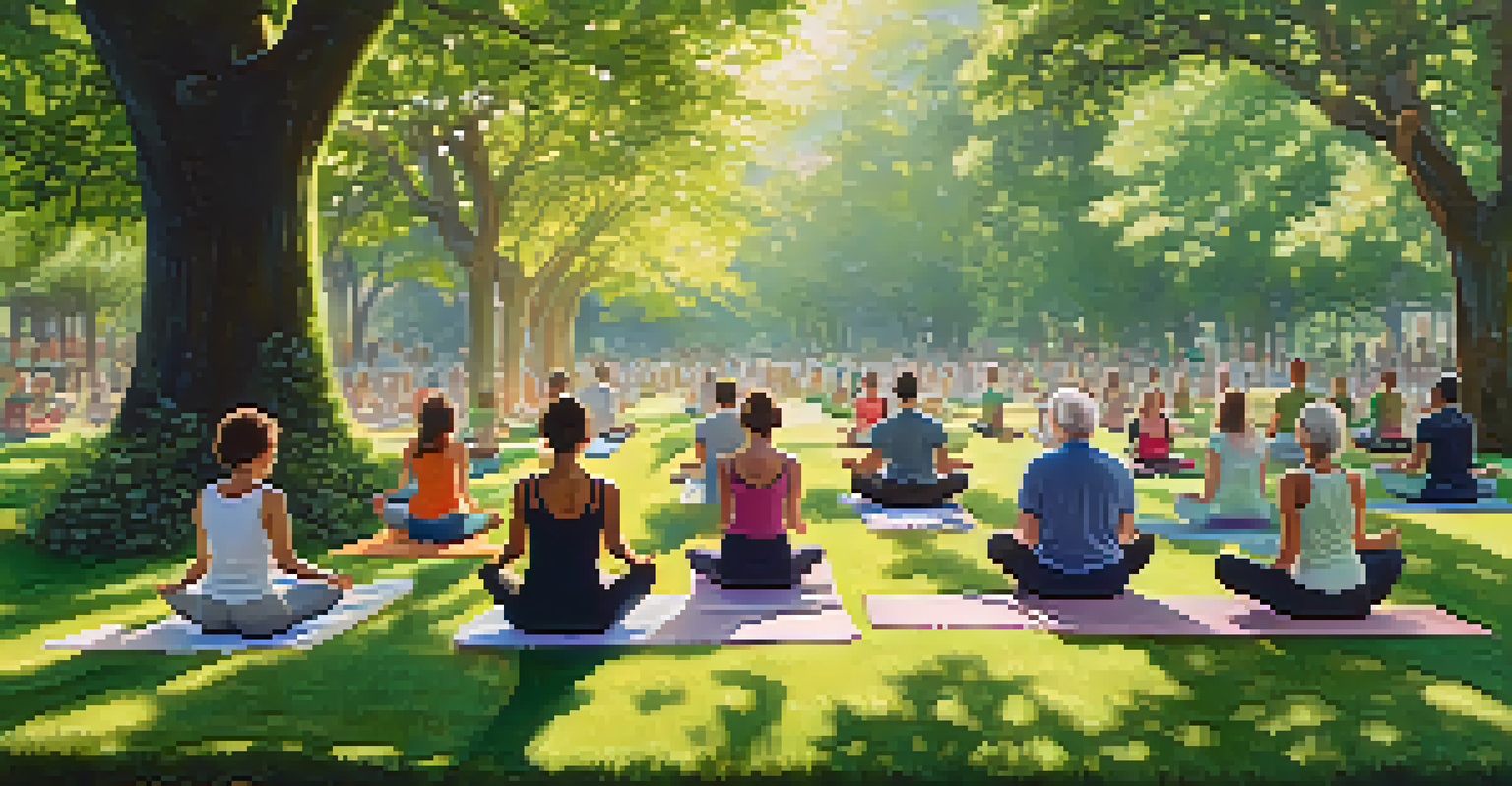Gentle Yoga: Cultivating Empathy Through Soft Movements

What is Gentle Yoga and Its Purpose?
Gentle yoga is a soothing practice that emphasizes soft movements and mindfulness. It is designed for individuals of all ages and fitness levels, making it an accessible form of exercise. The primary purpose is to create a space for relaxation and self-discovery, allowing practitioners to connect with their bodies at their own pace.
Yoga is the journey of the self, through the self, to the self.
This practice often incorporates gentle stretches, breathing exercises, and meditation, cultivating a sense of inner peace. Unlike more vigorous styles of yoga, gentle yoga prioritizes comfort and ease, making it a perfect gateway for those new to yoga or looking to reduce stress. In essence, it invites you to slow down and tune into your feelings.
By embracing gentle movements, participants can explore their physical and emotional landscapes. As the body softens, so too does the mind, fostering a compassionate attitude towards oneself and others. This connection between body and mind is a crucial step in cultivating empathy.
The Role of Soft Movements in Building Empathy
Soft movements in yoga can significantly enhance emotional awareness and empathy. When you practice gentle yoga, you're encouraged to listen to your body, which helps you become more attuned to your feelings. This awareness not only supports self-compassion but also enhances your ability to empathize with others.

For instance, as you gently stretch and breathe, you may notice areas of tension or discomfort within yourself. Recognizing these sensations allows you to appreciate the struggles others might face. This shared understanding can lead to deeper connections and a more empathetic perspective in your interactions.
Gentle Yoga Promotes Relaxation
Gentle yoga focuses on soft movements and mindfulness, creating a calming space for relaxation and self-discovery.
Moreover, the non-judgmental atmosphere of gentle yoga creates a safe space for vulnerability. When you practice in a supportive environment, you learn to accept imperfections, both in yourself and in others. This acceptance is a foundational element of empathy.
Mindfulness: The Heart of Gentle Yoga
Mindfulness is a cornerstone of gentle yoga, allowing practitioners to engage fully in the present moment. Through gentle stretches and breath awareness, you learn to observe your thoughts and feelings without judgment. This practice of being present helps you cultivate a deeper understanding of your own emotional state.
The greatest gift you can give someone is your time and attention.
When you're mindful, you become more aware of how your emotions influence your interactions with others. This awareness enables you to respond thoughtfully rather than reactively, fostering a more empathetic approach in your relationships. Essentially, mindfulness teaches you to pause and consider the feelings of those around you.
As you develop your mindfulness practice, you may find that empathy comes more naturally. The ability to see things from another's perspective grows stronger, enriching your connections with friends, family, and even strangers. Mindful moments in gentle yoga serve as powerful reminders of the importance of compassion.
Breathing Techniques that Enhance Empathy
Breathing techniques play a vital role in gentle yoga, influencing both physical and emotional well-being. Deep, conscious breathing can help calm the nervous system and reduce stress, allowing you to enter a more relaxed state. This calmness is essential for fostering empathy, as it creates space for reflection and connection.
As you practice specific breathing exercises, such as diaphragmatic breathing, you may notice a shift in your emotional landscape. This technique encourages you to breathe deeply into your abdomen, promoting relaxation and clarity. When your mind is clear, it's easier to empathize with others.
Empathy Grows Through Shared Practice
Practicing gentle yoga in a supportive community fosters vulnerability and connection, enhancing empathy among participants.
In addition, synchronized breathing with movements can cultivate a sense of unity and connection among practitioners. Whether in a small class or a larger group, breathing together fosters a shared experience that deepens your bond with others. This shared rhythm can amplify feelings of empathy and understanding.
Creating a Supportive Community Through Gentle Yoga
Gentle yoga often thrives in community settings, where practitioners come together to share their experiences. This supportive environment encourages vulnerability, making it easier for individuals to express their feelings. As you practice alongside others, you develop a sense of belonging that nurtures empathy.
In group classes, sharing stories or insights can foster deep connections among participants. These shared experiences can illuminate common struggles and triumphs, reinforcing the idea that we are all in this together. This sense of community can be a powerful catalyst for developing empathy.
Furthermore, gentle yoga communities often prioritize inclusivity and acceptance. By embracing individuals from diverse backgrounds, these spaces promote understanding and compassion. This exposure to different perspectives enriches your practice and strengthens your capacity for empathy.
Gentle Yoga for All Ages: Building Empathy Across Generations
One of the beautiful aspects of gentle yoga is its adaptability for all ages, from children to seniors. This inclusivity allows for intergenerational connections, fostering empathy across different life stages. Practicing together can bridge gaps in understanding and experience, enriching the lives of all participants.
For example, a family yoga session can offer opportunities for children to learn from their parents and grandparents. As they perform gentle movements together, they share laughter, stories, and insights, creating lasting memories. These moments strengthen familial bonds and promote empathy within the family unit.
Mindfulness Enhances Emotional Awareness
Mindfulness in gentle yoga helps practitioners observe their thoughts and feelings, leading to greater emotional understanding and empathy.
Moreover, when younger generations witness the grace and resilience of older practitioners, it cultivates respect and understanding. This dynamic exchange of experiences can lead to more meaningful relationships and a deeper appreciation for the challenges each generation faces.
Practical Tips for Cultivating Empathy Through Gentle Yoga
To cultivate empathy through gentle yoga, start by incorporating mindfulness into your practice. Begin each session with a few moments of stillness, focusing on your breath and setting an intention to connect with your feelings. This simple act can lay the groundwork for deeper empathy.
Next, try practicing with others whenever possible. Whether in a class or at home with friends, sharing the experience can enhance your understanding of different perspectives. As you move and breathe together, take time to discuss your feelings and observations, fostering empathy through dialogue.

Finally, remember to practice self-compassion. Allow yourself to feel whatever arises during your practice, and acknowledge that empathy begins with how we treat ourselves. The more gentle and understanding you are with yourself, the more equipped you'll be to extend that kindness to others.